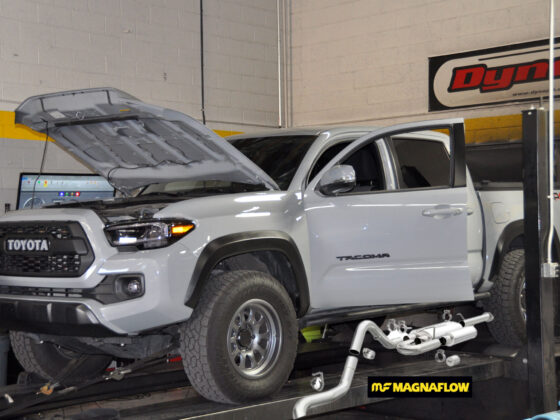 The rear suspension is nothing like any other Mustang. Inboard mounted dampers and tubular rear subframe? What? Again, the decorative exhaust tips throw me off.
The rear suspension is nothing like any other Mustang. Inboard mounted dampers and tubular rear subframe? What? Again, the decorative exhaust tips throw me off.
 More billet machined parts everywhere and serious rear brake cooling.
More billet machined parts everywhere and serious rear brake cooling.
 I THINK those are all spherical bearings with rubber dust boots. I could be wrong though.
I THINK those are all spherical bearings with rubber dust boots. I could be wrong though.
 I was behind a GR Supra at my last track day and it is quick!
I was behind a GR Supra at my last track day and it is quick!
 The GR comes with this nice engine bay bracing. It is common for BMWs to have the equivalent of the orange bars on all their more pedestrian models. The performance BMWs have a full U-shape which this GR Supra accomplishes with the black brace connecting to the two orange bars.
The GR comes with this nice engine bay bracing. It is common for BMWs to have the equivalent of the orange bars on all their more pedestrian models. The performance BMWs have a full U-shape which this GR Supra accomplishes with the black brace connecting to the two orange bars.
 It is hard to see, but there is some airflow path in the front bumper opening which I recall dumps into the front wheel well area. I think the purpose is to help cool the front brakes. I am not a fan of the non-functional closed off portion.
It is hard to see, but there is some airflow path in the front bumper opening which I recall dumps into the front wheel well area. I think the purpose is to help cool the front brakes. I am not a fan of the non-functional closed off portion.




10 comments
Dang, I was hoping to see to coaxial turbine turbo trickle down to the IC market before things went Full ICE.
Oops, I meant Full EV.
I’m curious to see if/when more e-turbo makes it onto cars. Mercedes has a Garrett e-turbo on one of their AMG cars. Genesis has a 48V electric supercharger and e-turbo uses the same 48V. With more cars coming hybrid like all the new super cars from Ferrari and McLaren, one logical step is e-turbo. Conversely, they could just say the electric motor does the torque filling.
Yeah, we have probably hit ‘Peak Turbo’ in our civilization, but I was kind of hoping to see the development of these turbos stretched out a bit more.
“The amount of turbocharger lag plays a key role in the driver’s perceived quality of a passenger vehicle’s engine response. This paper investigates an alternative method to the conventional design of a turbocharger turbine to improve the transient response of a passenger vehicle. The investigation utilises the Ford Eco-Boost 1.6 L petrol engine, an established production engine, equipped with a turbocharger of similar performance to the GT1548 produced by Honeywell. The commercially available Ricardo WAVE was used to model the engine. Comparing the steady-state performance showed that the axial turbine provides higher efficiencies at all operating conditions of an engine. The transient case demonstrated an improved transient response at all operating conditions of the engine. The study concluded that, by designing a similar sized axial turbine, the mass moment of inertia can be reduced by 12.64% and transient response can be improved on average by 11.76%, with a maximum of 21.05% improvement. This study provides encouragement for the wider application of this turbine type to vehicles operating on dynamic driving cycles such as passenger vehicles, light commercial vehicles, and certain off-road applications.”
https://www.mdpi.com/2076-3417/10/21/7452
Bummer this turbo didn’t make it into serial production. I wrote about it a while ago. https://motoiq.com/the-secret-turbo-in-the-ring-slaying-porsche-919-evo-honeywell-garrett-dualboost-for-gasoline-turbocharger/
Yeah, that’s the turbo!
“The amount of turbocharger lag plays a key role in the driver’s perceived quality of a passenger vehicle’s engine response. This paper investigates an alternative method to the conventional design of a turbocharger turbine to improve the transient response of a passenger vehicle. The investigation utilises the Ford Eco-Boost 1.6 L petrol engine, an established production engine, equipped with a turbocharger of similar performance to the GT1548 produced by Honeywell. The commercially available Ricardo WAVE was used to model the engine. Comparing the steady-state performance showed that the axial turbine provides higher efficiencies at all operating conditions of an engine. The transient case demonstrated an improved transient response at all operating conditions of the engine. The study concluded that, by designing a similar sized axial turbine, the mass moment of inertia can be reduced by 12.64% and transient response can be improved on average by 11.76%, with a maximum of 21.05% improvement. This study provides encouragement for the wider application of this turbine type to vehicles operating on dynamic driving cycles such as passenger vehicles, light commercial vehicles, and certain off-road applications.”
https://www.mdpi.com/2076-3417/10/21/7452
So true…there’s a snail shell design for maximum vortex compound combustion…but, that’s kinda secret, for now.
1. The GTD rear suspension looks to be based on the GT500 rear. Probably tweaked a bit and converted to inbound dampers. Lower arm looks very chunky, probably just a prototype still.
The front is very interesting. Based on other photos i have found online, the vertical height difference between the multilink lower “arm” pivot points looks to be over 2 inches.
The exhaust tips are probably very thin wall titanium, as they are made by Akrapovic.
2. The LT6 is impressive, the bore/stroke ratio is even greater than that of the 458.
And the design of the Z06 is what the C8 should have been from the start.
3. That WRX thing is hideous, oh my god.
Appreciate the comments! 3. To be fair, the WRX has never been a looker, ha!
Nothing says Nissan fanboy like a Nismo bathrobe. Nothing makes you look like more of a weirdo than a Nismo bathrobe. I’d rock one!